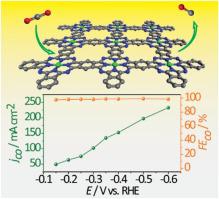Applied Catalysis B: Environment and Energy ( IF 22.1 ) Pub Date : 2020-11-25 , DOI: 10.1016/j.apcatb.2020.119739 Shuting Wei , Haiyuan Zou , Weifeng Rong , Fuxiang Zhang , Yongfei Ji , LeLe Duan

|
Electrochemical CO2 reduction driven by intermittent renewable energy sources is usually limited by output voltage fluctuation caused by their spatial and temporal discontinuities of those renewable energy sources. The development of high-performance catalysts with large current density and high selectivity for the target products in a wide operating potential window is of great importance for utilizing intermittent renewable electricity for CO2 reduction. Herein, we report a two-dimensional (2D) Ni phthalocyanine polymer (NiPcP) that displays superior catalytic activity and high selectivity for CO2-to-CO conversion with a Faradaic efficiency (FECO) over 98% in a wide operating potential window from –0.15 to –0.60 V and a maximum current density of 236 mA cm–2 at –0.6 V. At an overpotential of 0.39 V, NiPcP delivers a nearly 100% FE of CO production, a large CO current density of 197 mA cm–2 and an impressive TOF of 23148 h–1. Experimental and theoretical results disclose that the inherent electronic structure of Ni units, conjugated nature and hydrophobicity of NiPcP promote the CO2RR to CO production and restrain the competitive hydrogen evolution reaction, thereby enhancing the catalytic activity and selectivity for CO2-to-CO conversion. This work emphasizes the importance of modulating the structure and hydrophobicity of nanostructured catalysts for enhancing CO2RR performance.
中文翻译:

共轭镍酞菁镍聚合物在较宽的工作潜力范围内选择性催化CO 2到CO的转化
间歇性可再生能源驱动的电化学CO 2还原通常受限于由这些可再生能源的空间和时间不连续性引起的输出电压波动。开发具有大电流密度和高选择性的目标催化剂,在宽的工作潜力范围内的高性能催化剂,对于利用间歇性可再生电力减少CO 2至关重要。在本文中,我们报道了二维(2D)的Ni酞菁聚合物(NiPcP),其显示优异的催化活性高,用于CO选择性2 -to-CO转化用法拉第效率(FE CO)在–0.15至–0.60 V的宽工作电势范围内,且–0.6 V时的最大电流密度为236 mA cm –2时,超过98%。在0.39 V的过电势下,NiPcP可产生近100%的CO产生FE ,CO电流密度大,为197 mA cm –2,TOF为23148 h –1。实验和理论结果表明,Ni单元的固有电子结构,NiPcP的共轭性质和疏水性可促进CO 2 RR生成CO并抑制竞争性氢释放反应,从而增强对CO 2的催化活性和选择性。-CO转换。这项工作强调了调节纳米结构催化剂的结构和疏水性以增强CO 2 RR性能的重要性。

























 京公网安备 11010802027423号
京公网安备 11010802027423号